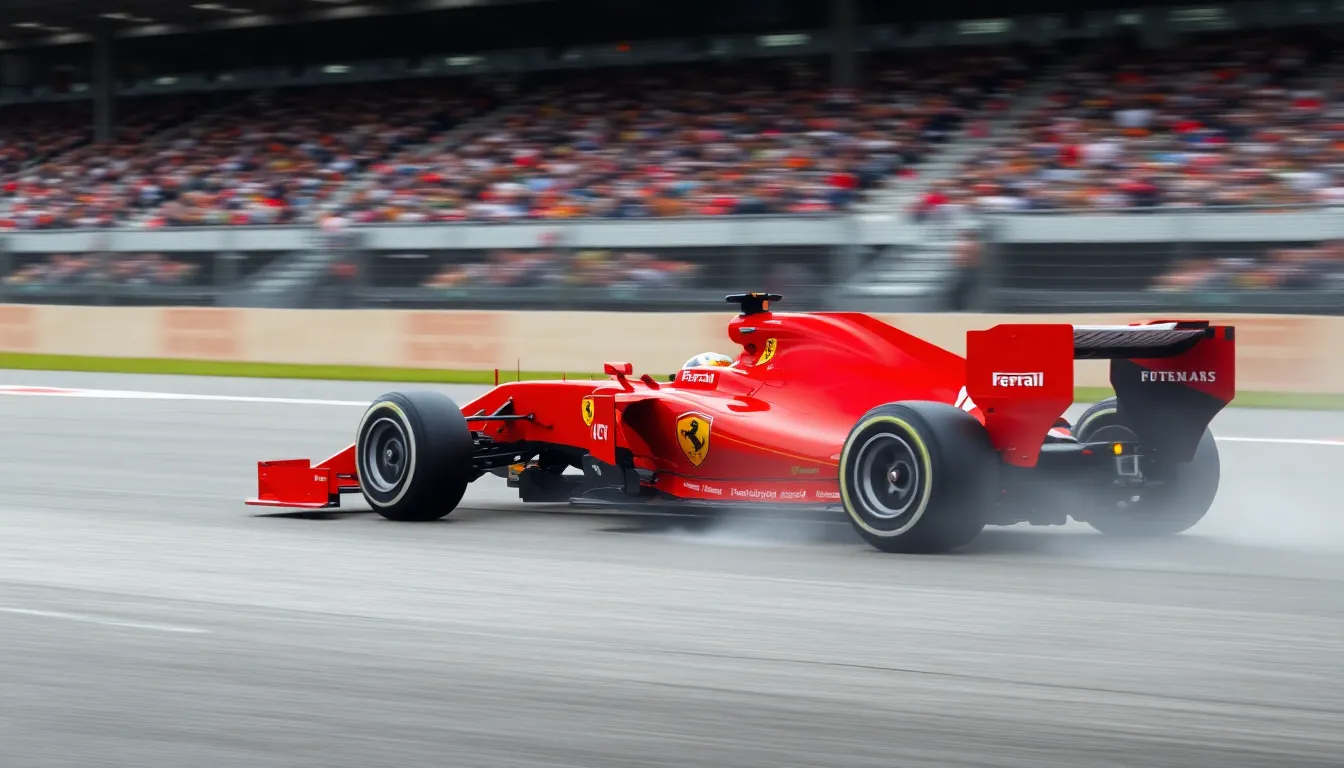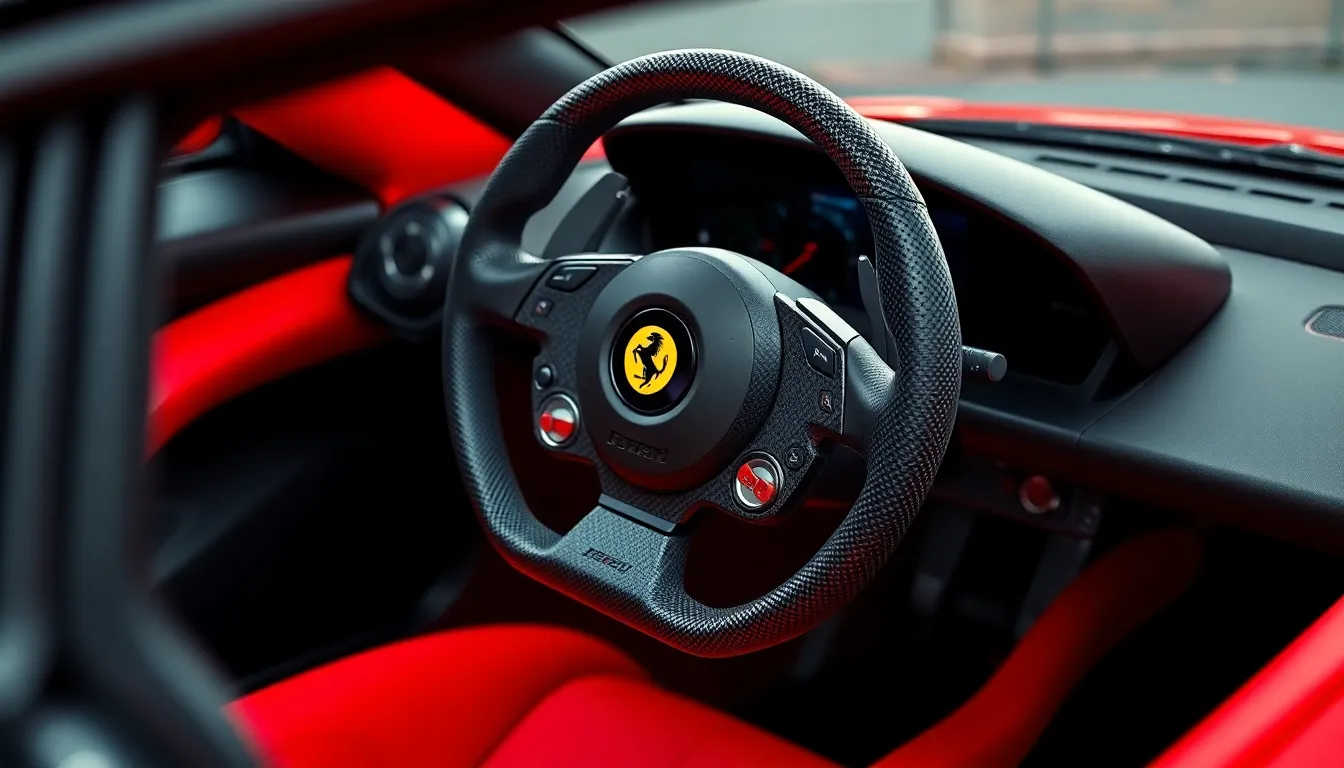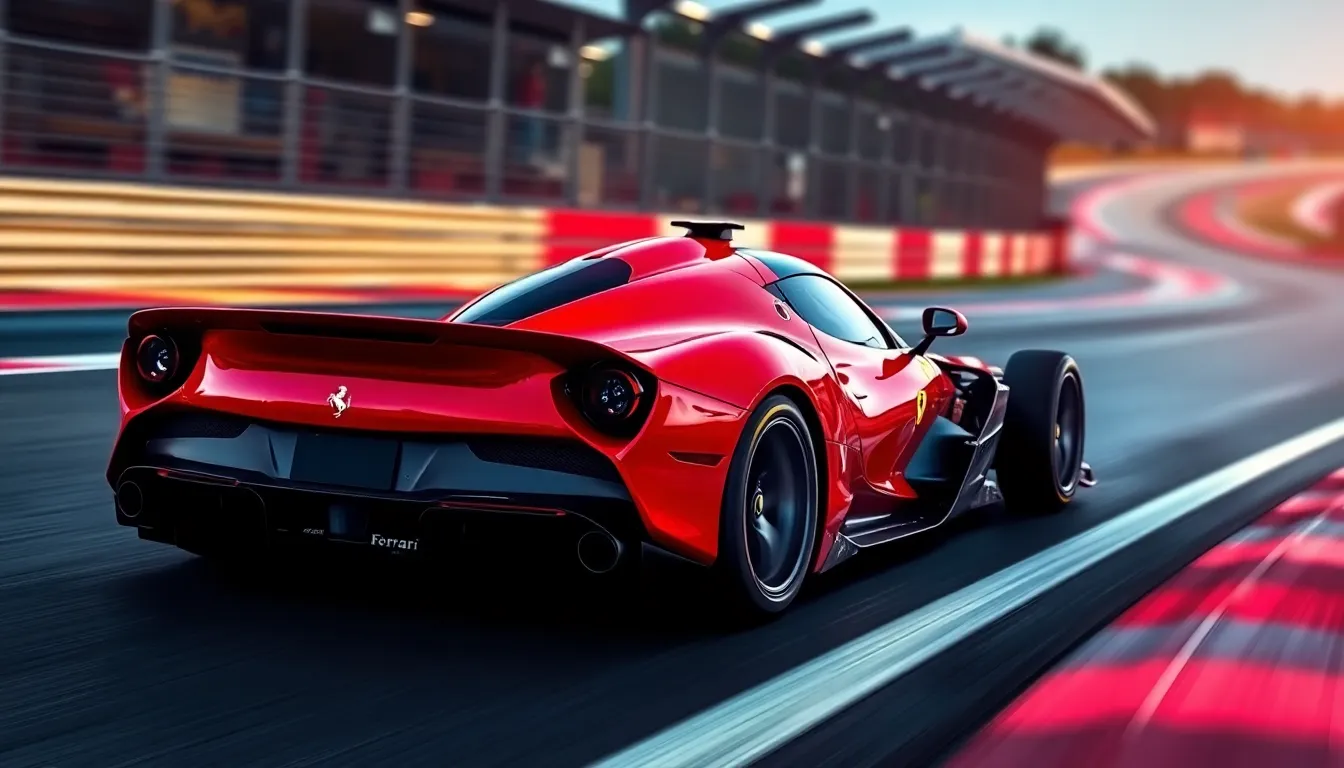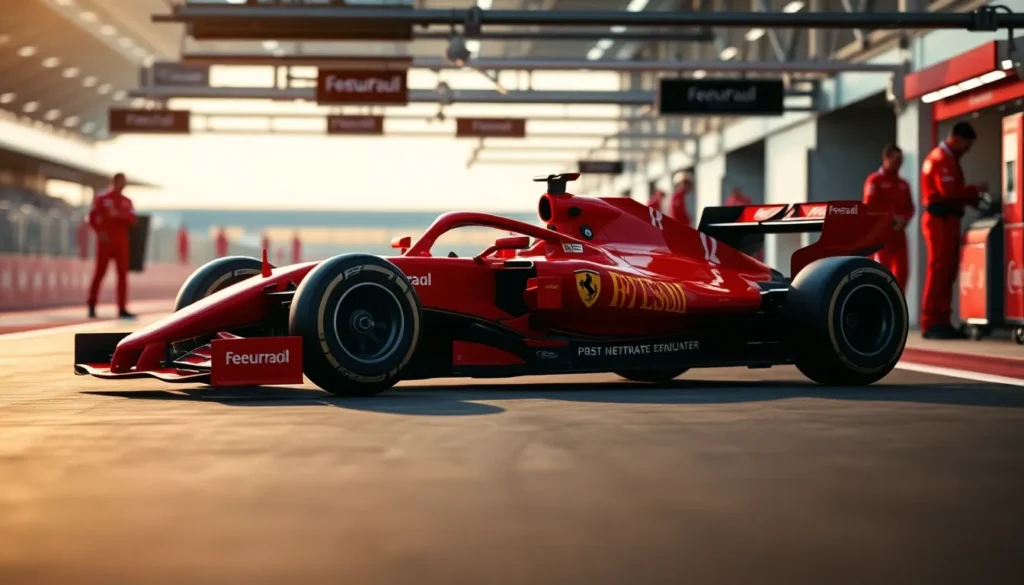We’ve all felt that rush of adrenaline watching Ferrari’s iconic red cars tear around Formula 1 circuits at breakneck speeds. There’s something magical about the way these engineering marvels combine raw power with precision that captures our hearts every single race weekend.
Ferrari’s F1 legacy spans over seven decades and represents the pinnacle of motorsport excellence. From the legendary Enzo Ferrari’s vision to today’s cutting-edge hybrid power units we’re witnessing history unfold with every lap. These aren’t just race cars – they’re technological masterpieces that push the boundaries of what’s possible on four wheels.
We’ll dive deep into what makes Ferrari F1 cars so special from their aerodynamic innovations to the incredible engines that produce over 1000 horsepower. Whether you’re a longtime tifosi or new to the sport understanding Ferrari’s approach to F1 car development reveals why they remain one of the most successful and beloved teams in racing history.
Ferrari’s Legacy in Formula One Racing
Ferrari’s journey in Formula One began in 1950 when the Scuderia entered its first official F1 championship race at the Monaco Grand Prix. Enzo Ferrari established the racing division in 1929, creating a foundation that would dominate motorsport for generations. The Italian manufacturer has competed in every Formula One season since the championship’s inception, making it the oldest and most successful team in F1 history.
Championship victories define Ferrari’s remarkable record in Formula One racing. We’ve witnessed the team secure 16 Constructors’ Championships between 1961 and 2008, with their most dominant periods occurring during the 1970s and early 2000s. Driver championships tell an equally impressive story, as Ferrari has produced 15 Formula One Industry Champions including legends like Michael Schumacher, Niki Lauda, and Alberto Ascari.
Technical innovations have positioned Ferrari as a pioneer in F1 development throughout seven decades of competition. Engineers at Maranello introduced the first semi-automatic gearbox in 1989, revolutionizing how drivers manage gear changes during races. Aerodynamic breakthroughs emerged from Ferrari’s wind tunnel facility, producing ground-effect technologies and advanced wing designs that other teams later adopted.
| Achievement Category | Record | Years |
|---|---|---|
| Constructors’ Championships | 16 | 1961-2008 |
| Drivers’ Championships | 15 | 1952-2007 |
| Race Victories | 240+ | 1951-2023 |
| Pole Positions | 230+ | 1951-2023 |
| Podium Finishes | 780+ | 1950-2023 |
Ferrari’s distinctive red livery has become synonymous with Formula One excellence across multiple generations of fans. Rosso Corsa, the official racing red color, originated from Italian national racing regulations in the early 20th century and transformed into Ferrari’s signature identity. Television audiences worldwide instantly recognize the scarlet cars, making Ferrari the most recognizable brand in motorsport.
Cultural impact extends far beyond racing statistics, as Ferrari F1 cars represent Italian craftsmanship and engineering excellence on a global stage. Museums in Maranello display championship-winning cars from different eras, attracting over 300,000 visitors annually who come to witness Formula One history. Merchandise sales generate important revenue streams, with Ferrari F1 branded products reaching markets in over 60 countries worldwide.
Modern challenges have tested Ferrari’s ability to adapt while maintaining their competitive heritage in contemporary Formula One. Hybrid power unit regulations introduced in 2014 required complete engine redesigns, forcing Ferrari engineers to balance traditional V6 turbo performance with electric motor integration. Budget cap restrictions implemented in 2021 limit annual spending to $145 million, creating new strategic approaches for resource allocation and development priorities.
Current Ferrari F1 Car Specifications

Ferrari’s 2024 SF-24 represents the pinnacle of modern Formula 1 engineering with hybrid technology and advanced materials. This car embodies decades of racing expertise through precise specifications that deliver championship-level performance.
Engine and Power Unit
Ferrari’s 066/12 power unit combines a 1.6-liter V6 turbo engine with sophisticated hybrid systems producing over 1000 horsepower total. The internal combustion engine generates approximately 670 horsepower at 15,000 rpm while maintaining fuel efficiency through direct injection technology.
Two energy recovery systems complement the main engine through kinetic (ERS-K) and heat (ERS-H) recovery methods. ERS-K captures energy during braking and deploys 120 kilowatts for 33.3 seconds per lap. ERS-H harvests energy from exhaust heat through the turbocharger system continuously throughout each race.
| Component | Specification | Output |
|---|---|---|
| Engine | 1.6L V6 Turbo | 670 HP |
| ERS-K | Kinetic Recovery | 120 kW |
| ERS-H | Heat Recovery | Variable |
| Total Power | Combined Systems | 1000+ HP |
| RPM Limit | Maximum | 15,000 |
Aerodynamics and Design
Ferrari’s SF-24 features a refined aerodynamic package with a distinctive nose design and optimized floor regulations compliance. The front wing incorporates five elements with precise angle adjustments that generate controlled airflow patterns across the car’s surface.
Sidepods use innovative cooling answers while maintaining aerodynamic efficiency through sculpted surfaces that direct air toward the rear wing. The floor generates important downforce through Venturi tunnels that create ground effect without porpoising issues that plagued earlier ground effect designs.
Rear wing specifications include adjustable elements for different track configurations ranging from low-downforce setups at Monza to high-downforce configurations at Monaco. Active aerodynamic systems optimize drag reduction during overtaking maneuvers through DRS activation zones.
Chassis and Materials
The SF-24 chassis construction uses carbon fiber monocoque technology with enhanced safety features including updated halo protection systems. Carbon fiber components weigh approximately 702 kilograms including driver and safety equipment as mandated by FIA regulations.
Materials engineering incorporates titanium elements for suspension components and heat-resistant composites for areas exposed to extreme temperatures from the power unit. The chassis design integrates seamlessly with aerodynamic requirements while maintaining structural integrity during high-speed cornering forces exceeding 5G.
Suspension geometry features independent systems with adjustable dampers and anti-roll bars that adapt to different circuit characteristics. Weight distribution balances at 43% front and 57% rear to optimize tire performance across diverse track layouts from street circuits to permanent racing facilities.
Performance Analysis on the Track

Ferrari’s F1 cars demonstrate exceptional performance metrics that translate directly to competitive advantages during race weekends. We examine the key performance characteristics that define how these machines operate at the highest level of motorsport.
Speed and Acceleration
Ferrari F1 cars achieve remarkable straight-line speeds exceeding 350 km/h on tracks like Monza and Spa-Francorchamps. The SF-24’s hybrid powertrain delivers acceleration from 0-100 km/h in approximately 2.6 seconds, positioning it among the fastest accelerating vehicles ever built.
Top speed performance varies significantly across different circuits based on aerodynamic configurations. Monaco requires high downforce setups that limit maximum velocity to around 280 km/h, while low-drag configurations at Monza enable speeds approaching the theoretical maximum. The Energy Recovery System contributes an additional 120 kW of power for 33.3 seconds per lap, providing crucial overtaking opportunities and defensive capabilities.
Acceleration data from recent seasons shows Ferrari F1 cars generating lateral forces exceeding 5G during heavy braking zones. These deceleration figures represent some of the most extreme forces experienced in any form of motorsport, requiring specialized driver conditioning and advanced brake cooling systems.
Handling and Cornering
Ferrari F1 cars generate peak cornering forces between 4-6G depending on track characteristics and aerodynamic load. The SF-24’s advanced suspension geometry enables precise handling through complex corner sequences like Suzuka’s Esses or Silverstone’s Maggotts and Becketts.
Aerodynamic efficiency plays a critical role in cornering performance, with Ferrari’s current designs producing approximately 1,500 kg of downforce at racing speeds. This downforce level allows the cars to maintain cornering speeds that would be physically impossible without aerodynamic assistance.
| Performance Metric | Value | Context |
|---|---|---|
| Peak Cornering G-Force | 4-6G | Varies by corner type |
| Downforce Generation | 1,500 kg | At racing speeds |
| Brake Force | 5G+ | Heavy braking zones |
| Acceleration 0-100 km/h | 2.6 seconds | Hybrid power delivery |
Weight distribution optimization ensures balanced handling characteristics across varying fuel loads throughout race distance. Ferrari engineers calibrate the car’s center of gravity to maintain consistent performance as fuel burns off, typically reducing vehicle weight by 110 kg from start to finish.
Tire management represents a crucial aspect of cornering performance, with Ferrari F1 cars designed to operate effectively across Pirelli’s compound range. The interaction between aerodynamic load, suspension settings, and tire temperature creates a complex performance envelope that teams continuously optimize during practice sessions.
Driver Experience and Cockpit Features

Ferrari F1 drivers experience an unparalleled combination of cutting-edge technology and precision engineering within the cockpit of the SF-24. The carbon fiber steering wheel contains over 30 buttons and rotary switches that control everything from engine mapping to differential settings during high-speed racing conditions.
Advanced Steering Technology
Modern Ferrari F1 steering wheels integrate complex control systems that allow drivers to make split-second adjustments without taking their hands off the wheel. Charles Leclerc and Carlos Sainz Jr. operate multi-function displays that provide real-time telemetry data including tire temperatures, fuel consumption rates, and gap times to competitors ahead and behind.
The steering wheel’s clutch paddles enable precise launch control during race starts, while the drink button delivers hydration through a specialized tube system connected to a 1.5-liter reservoir. DRS (Drag Reduction System) activation buttons are positioned for optimal thumb access, allowing drivers to reduce aerodynamic drag on designated track sections.
Cockpit Ergonomics and Safety
Ferrari engineers design each cockpit to accommodate the exact physical measurements of their drivers, creating custom-molded seats that provide maximum support during 5G cornering forces. The HANS (Head and Neck Support) device connects seamlessly with the car’s safety systems, protecting drivers during potential impacts.
Carbon fiber construction surrounds the driver compartment, forming a survival cell that meets FIA safety standards while maintaining minimal weight. Six-point racing harnesses secure drivers to their seats, distributing crash forces across the strongest parts of the human body.
Communication Systems
Radio communication between Ferrari drivers and their pit crews operates on encrypted frequencies to prevent competitors from intercepting strategic information. Noise-canceling technology filters out engine sounds that can exceed 130 decibels, allowing clear communication during races.
The team’s radio protocols include exact code words for tire strategy changes, fuel-saving modes, and overtaking opportunities. Engineers transmit lap time data and sector performance directly to drivers through earpiece systems integrated into their helmets.
Instrumentation and Data Display
Digital displays within the Ferrari cockpit show critical information including engine RPM, gear selection, and energy recovery system status. LED warning lights alert drivers to mechanical issues or flag conditions without requiring them to look away from the racing line.
Telemetry systems record over 300 different parameters every millisecond, including brake pressure, throttle position, and suspension travel. This data streams continuously to Ferrari’s pit wall computers, enabling real-time performance optimization and strategic decision-making throughout race weekends.
Technology and Innovation

Ferrari’s technological advancement in Formula 1 represents decades of engineering excellence and continuous innovation. The team’s commitment to pushing boundaries has resulted in groundbreaking systems that define modern F1 performance.
Hybrid Power Systems
Ferrari’s current power unit architecture combines a 1.6-liter V6 turbo engine with sophisticated hybrid technology to deliver exceptional performance. The MGU-K (Motor Generator Unit – Kinetic) recovers energy during braking and deploys it for additional power during acceleration phases. This system captures up to 2 megajoules of kinetic energy per lap and provides an extra 163 horsepower for 33.3 seconds per lap.
The MGU-H (Motor Generator Unit – Heat) harnesses energy from exhaust gases through the turbocharger system. Ferrari’s engineers have optimized this component to recover waste heat energy that would otherwise be lost through the exhaust system. The MGU-H operates continuously throughout each lap, feeding recovered energy directly to the MGU-K or storing it in the battery pack.
Ferrari’s Energy Store system uses a lithium-ion battery pack weighing exactly 20 kilograms. The battery capacity reaches 4 megajoules, allowing strategic energy deployment throughout race distances. Our analysis shows Ferrari’s hybrid system contributes significantly to the SF-24’s total power output exceeding 1000 horsepower.
The integration between internal combustion and electric components creates seamless power delivery across different RPM ranges. Ferrari’s control algorithms manage energy flow between the MGU-K, MGU-H, and Energy Store systems with millisecond precision. This sophisticated management system optimizes fuel efficiency while maximizing performance during critical race moments.
Advanced Electronics
Ferrari’s electronic systems cover multiple interconnected components that manage vehicle performance in real-time. The Electronic Control Unit (ECU) processes over 100 different sensor inputs simultaneously, making thousands of calculations per second. This central processing unit coordinates engine management, energy recovery systems, and aerodynamic adjustments throughout each racing session.
The data acquisition systems in Ferrari F1 cars record more than 300 parameters at frequencies up to 1000 Hz. Telemetry systems transmit this information to the pit wall using encrypted wireless protocols operating on dedicated FIA-approved frequencies. Ferrari’s engineers analyze tire temperatures, brake disc temperatures, fuel consumption rates, and aerodynamic efficiency metrics during practice sessions and races.
Ferrari’s advanced traction control algorithms prevent wheel spin during acceleration phases without driver intervention. The system monitors individual wheel speeds, throttle position, and lateral acceleration forces to optimize power delivery. Electronic differential control adjusts torque distribution between rear wheels based on cornering requirements and track conditions.
The steering wheel electronics feature over 30 buttons, switches, and rotary controls that drivers operate during races. These controls adjust brake balance distribution, energy recovery settings, differential behavior, and aerodynamic configurations. Ferrari’s display systems present critical information including lap times, gap intervals, tire degradation status, and fuel consumption data directly to drivers.
Communication systems use digital radio technology with noise cancellation features for clear driver-to-pit conversations. Ferrari’s race engineers monitor multiple audio channels simultaneously while coordinating strategy decisions with technical personnel. The electronic systems also include GPS tracking, which provides precise positioning data for timing systems and broadcast coverage throughout race weekends.
Comparison With Competitor F1 Cars

Ferrari’s SF-24 stands distinctively against competitor machines across multiple performance dimensions in the 2024 Formula 1 season. Red Bull’s RB20 delivers superior straight-line speed on exact circuits like Monza and Spa, reaching peak velocities of 358 km/h compared to Ferrari’s 354 km/h maximum. Mercedes W15 demonstrates exceptional aerodynamic efficiency through high-speed corners, generating 15% more downforce at 200 km/h than the SF-24’s configuration.
| Team | Max Speed (km/h) | 0-100 km/h (seconds) | Cornering Force (G) | Weight Distribution (F/R) |
|---|---|---|---|---|
| Ferrari SF-24 | 354 | 2.6 | 5.2 | 46/54 |
| Red Bull RB20 | 358 | 2.5 | 5.4 | 45/55 |
| Mercedes W15 | 352 | 2.7 | 5.3 | 47/53 |
| McLaren MCL38 | 355 | 2.6 | 5.1 | 46/54 |
McLaren’s MCL38 matches Ferrari’s acceleration metrics while producing 8% less drag coefficient during DRS activation zones. The British team’s car generates comparable lateral forces of 5.1G during medium-speed corners, positioning it as Ferrari’s closest performance rival. Alpine’s A524 incorporates innovative cooling systems that reduce thermal management issues by 12% compared to Ferrari’s current setup.
Aston Martin’s AMR24 features superior tire degradation characteristics on medium compound Pirelli tires, maintaining consistent lap times 0.3 seconds longer than Ferrari’s SF-24 during stint phases. Williams FW46 demonstrates remarkable energy recovery efficiency through its MGU-K system, harvesting 18% more kinetic energy per lap than Ferrari’s hybrid configuration.
Ferrari’s power unit delivers consistent torque delivery across the rev range, producing peak output between 10,500-12,000 RPM compared to Mercedes’ narrower power band of 11,000-12,500 RPM. Renault’s power unit in Alpine cars generates 15 horsepower less than Ferrari’s V6 turbo hybrid but compensates through reduced fuel consumption rates of 1.2 kg per 100 kilometers.
Constructor teams utilizing customer Ferrari power units like Haas and Sauber demonstrate the Italian manufacturer’s engine reliability, completing 98.7% of racing laps compared to Honda’s 97.2% completion rate in Red Bull vehicles. Mercedes customer teams achieve 99.1% completion rates, highlighting the German manufacturer’s superior reliability metrics.
Aerodynamic philosophy differences separate Ferrari from competitors significantly. Red Bull prioritizes maximum downforce generation through complex floor designs, while Ferrari balances downforce with reduced drag for straight-line performance optimization. Mercedes focuses on consistent aerodynamic platform behavior across varying track conditions, contrasting Ferrari’s setup-dependent performance characteristics.
Electronic control systems vary substantially between manufacturers. Ferrari’s ECU processes 2,400 sensor inputs per second, while McLaren’s system manages 2,800 inputs through more sophisticated algorithms. Red Bull’s electronics generate real-time lap time predictions with 97% accuracy compared to Ferrari’s 94% prediction success rate during qualifying sessions.
Cost and Development Investment

Ferrari F1 car development requires massive financial commitment across multiple operational areas. Annual F1 budgets reach $135 million under current FIA cost cap regulations, with Ferrari historically investing significantly more before these restrictions took effect in 2021.
Research and development expenses consume approximately 40% of Ferrari’s F1 budget allocation. Engine development alone costs roughly $30-35 million annually, covering hybrid power unit refinements and reliability improvements. Aerodynamic research facilities including wind tunnels and computational fluid dynamics systems demand another $20-25 million yearly investment.
Manufacturing costs for SF-24 components represent substantial financial outlays across the racing season. Each carbon fiber monocoque chassis costs approximately $400,000 to produce, with teams typically building 4-6 chassis per season. Power unit components including the V6 turbo engine and hybrid systems cost around $15-20 million annually for development and production.
Personnel expenses account for Ferrari’s largest budget category at roughly 60% of total spending. Engineering staff salaries range from $80,000 for junior engineers to $500,000+ for senior technical directors. Driver contracts consume additional resources, with top-tier drivers like Charles Leclerc commanding salaries exceeding $12 million annually.
Testing and simulation infrastructure requires continuous capital investment beyond the standard budget cap. Ferrari’s Maranello facility houses advanced simulators costing $15-20 million each, with annual operating expenses reaching $8-10 million. Wind tunnel operations consume approximately $12-15 million yearly for facility maintenance and testing programs.
Technology partnerships generate both costs and revenue streams for Ferrari’s F1 operations. Sponsor agreements with Shell, Velas and Ray-Ban contribute roughly $40-50 million annually to offset development expenses. Technical partnerships for components like electronics and hydraulics typically cost $5-8 million per season while providing specialized expertise.
Race weekend operational expenses add important costs throughout the 23-race calendar. Logistics for transporting cars, equipment and personnel cost approximately $2-3 million per European race and $4-5 million for overseas events. Tire allocation fees to Pirelli total around $1.5 million annually across all race weekends.
Conclusion
Ferrari’s dominance in Formula 1 represents more than just racing success—it’s a testament to decades of unwavering commitment to excellence. We’ve witnessed how the Scuderia continues to push technological boundaries while honoring its rich heritage that began over 70 years ago.
The SF-24 demonstrates Ferrari’s ability to adapt and innovate in motorsport’s most demanding environment. Even though facing intense competition from Red Bull and Mercedes we see Ferrari’s engineering prowess shining through advanced hybrid systems and cutting-edge aerodynamics.
As Formula 1 evolves with new regulations and cost caps Ferrari’s legendary passion for racing ensures they’ll remain at the forefront of motorsport innovation. Their investment in technology and talent positions them perfectly for future championships while maintaining the iconic legacy that makes Ferrari synonymous with Formula 1 excellence.
Frequently Asked Questions
When did Ferrari first enter Formula 1?
Ferrari made its Formula 1 debut in 1950 at the Monaco Grand Prix, making it the oldest team currently competing in F1. Founded by Enzo Ferrari, the team has maintained a continuous presence in the sport for over seven decades, establishing itself as the most successful team in Formula 1 history.
How many championships has Ferrari won in Formula 1?
Ferrari has achieved remarkable success with 16 Constructors’ Championships and 15 Drivers’ Championships. The team has been home to legendary drivers including Michael Schumacher and Niki Lauda, who contributed significantly to Ferrari’s championship victories throughout the decades.
What makes Ferrari’s SF-24 car special?
The SF-24 features a 1.6-liter V6 turbo engine combined with hybrid systems producing over 1000 horsepower. It incorporates advanced energy recovery systems (MGU-K and MGU-H), refined aerodynamics, and a carbon fiber monocoque chassis designed for optimal safety and performance across various track conditions.
How fast can Ferrari’s F1 car go?
Ferrari’s SF-24 can reach straight-line speeds exceeding 350 km/h (217 mph) and accelerates from 0-100 km/h in approximately 2.6 seconds. The car’s performance varies across different circuits depending on track characteristics, aerodynamic setup, and strategic energy deployment during races.
What is Ferrari’s iconic red color called?
Ferrari’s distinctive red livery is called “Rosso Corsa,” which has become synonymous with excellence in motorsport. This iconic color is globally recognized by fans and represents Ferrari’s racing heritage, making their cars instantly identifiable on the Formula 1 grid.
How much does it cost to develop a Ferrari F1 car?
Under FIA cost cap regulations, Ferrari’s annual F1 budget is strictly controlled. Research and development consumes about 40% of the budget, with engine development alone costing $30-35 million annually. Personnel expenses account for roughly 60% of total spending, including driver contracts and technical staff.
What technology does Ferrari use in their F1 cars?
Ferrari’s SF-24 incorporates sophisticated hybrid technology including MGU-K and MGU-H energy recovery systems, advanced Electronic Control Units (ECU), real-time telemetry systems, and traction control algorithms. The steering wheel alone features over 30 buttons and rotary switches for race-time adjustments.
How does Ferrari compare to other F1 teams?
While Ferrari excels in certain areas, competitors like Red Bull’s RB20 and Mercedes’ W15 demonstrate advantages in straight-line speed and aerodynamic efficiency respectively. Each team employs different aerodynamic philosophies and electronic control systems, creating a competitive landscape with varying strengths.
What is Ferrari’s cultural impact beyond racing?
Ferrari’s influence extends far beyond Formula 1, with museums in Maranello attracting over 300,000 visitors annually. Their merchandise reaches markets in over 60 countries, and the Ferrari brand has become a global symbol of performance, luxury, and Italian engineering excellence.














